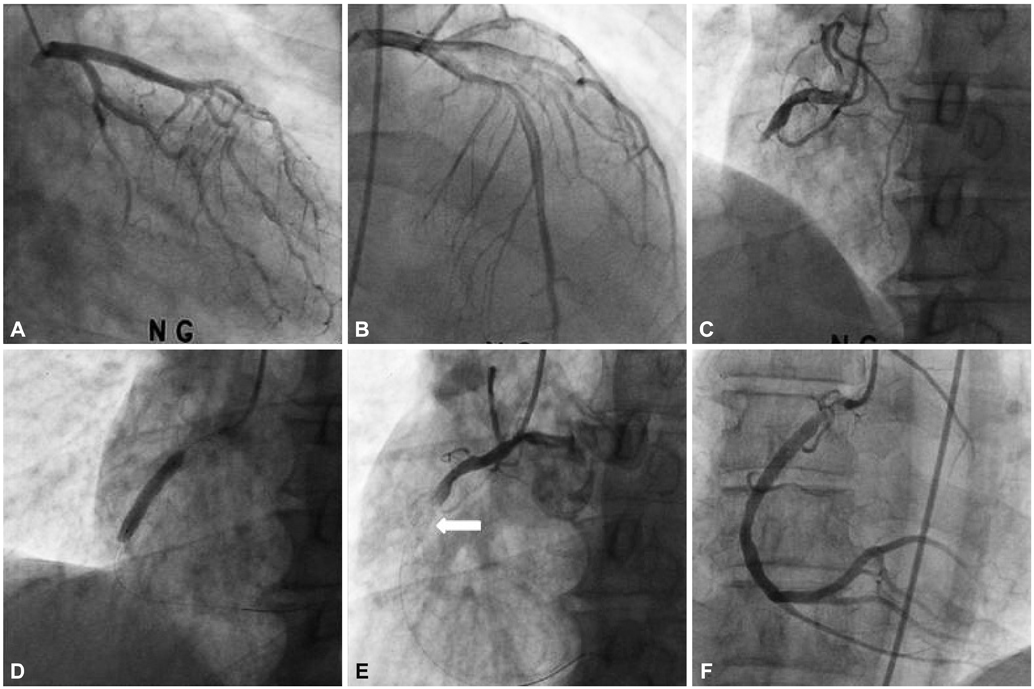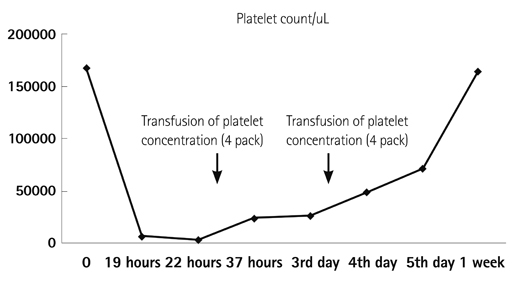Korean Circ J.
2013 Aug;43(8):557-560. 10.4070/kcj.2013.43.8.557.
Acute Profound Thrombocytopenia after Using Abciximab for No-Reflow during Primary Percutaneous Coronary Intervention for ST-Segment Elevation Myocardial Infarction
- Affiliations
-
- 1Regional Cardiovascular Center, Division of Cardiology, Department of Internal Medicine, Chungbuk National University Hospital, Cheongju, Korea. sangmin3410@gmail.com
- KMID: 2224846
- DOI: http://doi.org/10.4070/kcj.2013.43.8.557
Abstract
- Glycoprotein IIb/IIIa antagonists are well established for their effectiveness in improving clinical outcomes in acute coronary syndrome patients undergoing percutaneous coronary intervention. Acute profound thrombocytopenia is a rare complication of abciximab. We present a case which was managed successfully for the rare complication of acute profound thrombocytopenia after using abciximab and an intra-aortic balloon pump for the treatment of a no-reflow phenomenon and consecutive cardiogenic shock during primary percutaneous coronary intervention.
Keyword
MeSH Terms
Figure
Reference
-
1. Makoni SN. Acute profound thrombocytopenia following angioplasty: the dilemma in the management and a review of the literature. Heart. 2001; 86:E18.2. Coller BS. Blockade of platelet GPIIb/IIIa receptors as an antithrombotic strategy. Circulation. 1995; 92:2373–2380.3. Use of a monoclonal antibody directed against the platelet glycoprotein IIb/IIIa receptor in high-risk coronary angioplasty. The EPIC Investigation. N Engl J Med. 1994; 330:956–961.4. Lincoff AM, Mark DB, Tcheng JE, et al. Economic assessment of platelet glycoprotein IIb/IIIa receptor blockade with abciximab and low-dose heparin during percutaneous coronary revascularization: results from the EPILOG randomized trial. Evaluation in PTCA to Improve Long-term Outcome with abciximab GP IIb/IIIa blockade. Circulation. 2000; 102:2923–2929.5. EPISTENT Investigators. Randomised placebo-controlled and balloon-angioplasty-controlled trial to assess safety of coronary stenting with use of platelet glycoprotein-IIb/IIIa blockade. Lancet. 1998; 352:87–92.6. Merlini PA, Rossi M, Menozzi A, et al. Thrombocytopenia caused by abciximab or tirofiban and its association with clinical outcome in patients undergoing coronary stenting. Circulation. 2004; 109:2203–2206.7. Warkentin TE. Heparin-induced thrombocytopenia: pathogenesis and management. Br J Haematol. 2003; 121:535–555.8. Claeys LG, Berg W. Major bleeding and severe thrombocytopenia after combined heparin and abciximab-c7E3 Fab therapy. Eur J Vasc Endovasc Surg. 2003; 25:85–87.9. Klein LW, Kern MJ, Berger P, et al. Society of cardiac angiography and interventions: suggested management of the no-reflow phenomenon in the cardiac catheterization laboratory. Catheter Cardiovasc Interv. 2003; 60:194–201.10. Butler MJ, Chan W, Taylor AJ, Dart AM, Duffy SJ. Management of the no-reflow phenomenon. Pharmacol Ther. 2011; 132:72–85.11. Abbo KM, Dooris M, Glazier S, et al. Features and outcome of no-reflow after percutaneous coronary intervention. Am J Cardiol. 1995; 75:778–782.
- Full Text Links
- Actions
-
Cited
- CITED
-
- Close
- Share
- Similar articles
-
- No-Reflow Phoenomenon by Intracoronary Thrombus in Acute Myocardial Infarction
- Percutaneous Cardiopulmonary Support in Refractory No-Reflow with Cardiogenic Shock after Coronary Stenting in Acute Myocardial Infarction
- Coronary Flow Doppler Profile in No-Reflex Phenomenon after Direct PTCA in Acute Myocardial Infarction
- Spontaneous Bleeding from Internal Pudendal Artery associated with Abciximab after Primary Percutaneous Coronary Intervention: Successful Treatment with Percutaneous Gel-Foam Embolization
- Acute Stent Thrombosis and Heparin Induced Thrombocytopenia in a Patient With ST-Segment Elevation Myocardial Infarction



